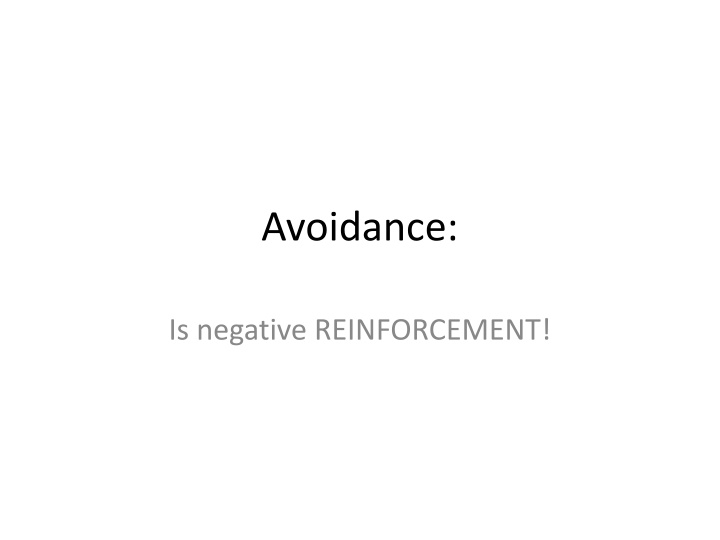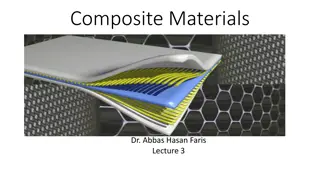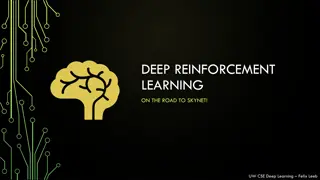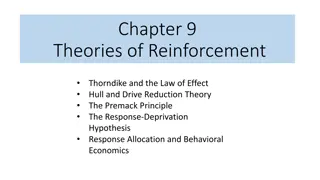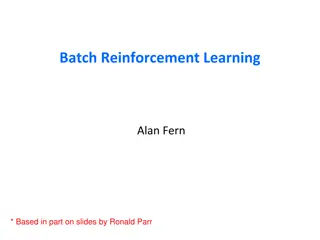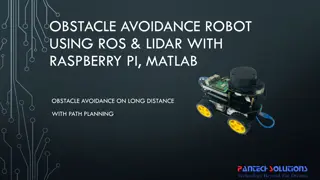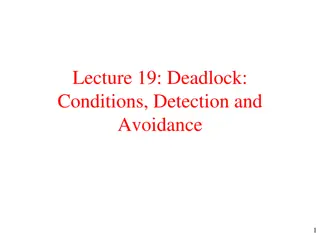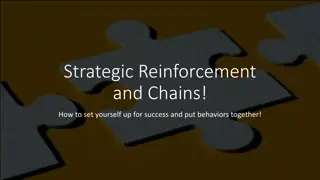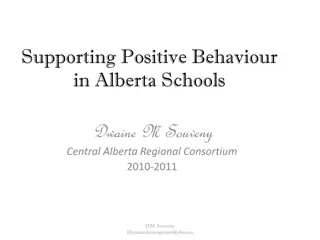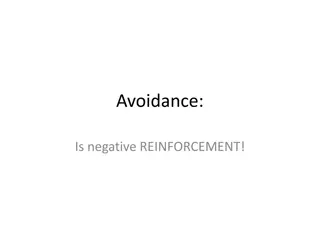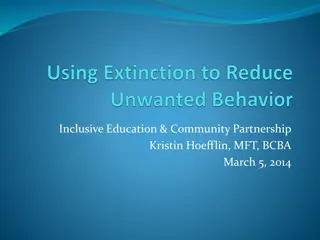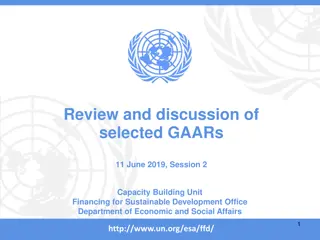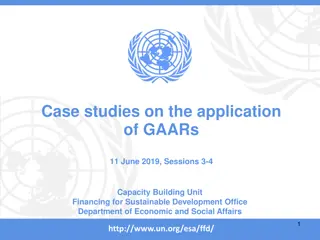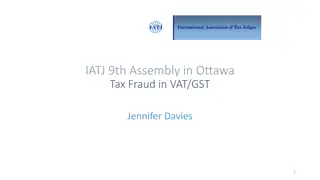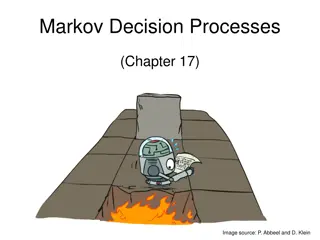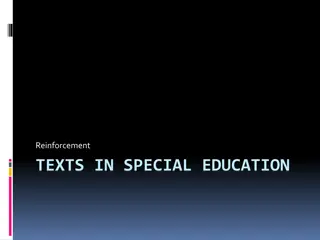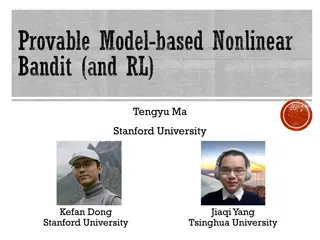Avoidance Behavior and Negative Reinforcement
Avoidance behavior involves the act of reducing contact with aversive stimuli through negative reinforcement, not punishment. This behavior is studied through discriminated avoidance tests, such as 1-way shuttle avoidance, shedding light on how organisms respond to avoidant contingencies. Theories like the Two Factor theory explain how animals learn to fear and subsequently avoid undesirable stimuli. Experimental evidence illuminates the physiological and psychological mechanisms at play in avoidance conditioning, showing how fear responses are replaced by escape behaviors over time.
Uploaded on Mar 05, 2025 | 0 Views
Download Presentation

Please find below an Image/Link to download the presentation.
The content on the website is provided AS IS for your information and personal use only. It may not be sold, licensed, or shared on other websites without obtaining consent from the author.If you encounter any issues during the download, it is possible that the publisher has removed the file from their server.
You are allowed to download the files provided on this website for personal or commercial use, subject to the condition that they are used lawfully. All files are the property of their respective owners.
The content on the website is provided AS IS for your information and personal use only. It may not be sold, licensed, or shared on other websites without obtaining consent from the author.
E N D
Presentation Transcript
Avoidance: Is negative REINFORCEMENT!
Avoidance contingencies INCREASE the rate of an operant response NOT punishment, but actually negative reinforcement Remember, punishment DECREASES the response What is avoidance behavior? But with both avoidance and punishment the organism reduces contact with an aversive stimulus! Increasing periods of safety Avoidance procedures = ACTIVE avoidance Punishment procedures = passive avoidance
Discriminated Avoidance: Procedure for studying negative reinforcement and avoidance A response CANCELS a shock Organism is responding for food reinforcers When light comes on, must press another lever to AVOID the shock Avoidance Tests: Discriminated Avoidance IF the response does not occur during the S+ the stimulus is followed by a shock IF the response does occur during the S+, the shock is cancelled Thus: signal or sD for shock If this were an escape: response could also occur DURING the shock to shut off shock
1-way shuttle avoidance: Animal on one side of a shuttle Cue comes on: Must jump to other (safety) side or receive a shock. Placed back in original side for each trial. Shuttle Avoidance 2-way shuttle avoidance Animal on one side of a shuttle Cue comes on: Must jump to other (safety) side or receive a shock. But: previously SAFE side then becomes shock side Animal must jump back into shock side to get away from shock. VERY Difficult for animal to learn.
Assume TWO things happen during avoidance conditioning: CC and then OC Animal learns to fear S+ via class. conditioning CS (light)---> US (shock): UR (fear) animal learns to fear light via pairing with shock Animal will then learn a response to AVOID shock and thus remove/lessen their fear Theories of Avoidance: Two Factor theory Thus: not getting shocked reduces fear that was signaled by the CS
Experimental evidence: On initial training trials: light/CS produces physiological symptoms of fear Theories of Avoidance: Two Factor theory Escape response results in decrease in these physiological symptoms On later trials: Little or no evidence of physiological fear with CS presentation Suggests fear has been reduced/replaced by the escape response In sense: forms a negative feedback loop
Signs of fear dissipate w/time: Problems with 2- factor theory: as animal gets "better" at avoidance response thus: no fear to be avoided The CS is not as important in avoidance learning as 2-factor theory states: Animals can learn to avoid in a discriminated avoidance situation long before there is any sign that they are responding to/detecting the CS
Sidman Avoidance: The response POSTPONES or DELAYS the shock Thus: only temporary solution Must keep responding to keep delaying the shock Results in lots of responding Again: some signal may be used to signal when must respond Two Avoidance Procedures: Why important? If fear was necessary, would freeze and be unable to respond to delay the shock
Herrnstein and Hineline Procedure: The response reduces the rate of the shock Does NOT delays or cancel, just slows down rate of delivery The response switches the schedule of shock to a lower rate Two Avoidance Procedures: Note: cannot entirely AVOID shock in this procedure: Once animal receives shock on lowered schedule, reverts back to original schedule Animal must respond again to switch schedule again
1 2 3 Test of 2 factor theory: 2-factor theory would predict: Results: Group 2 responds much more accurately, faster Two groups of rats used Group 1: Can turn off light, but still get shock Group 2: Can turn off shock, light still on Group 1 should respond more Why? This would be cancelling the CS that produces fear Herrnstein and Hineline: Test of 2-factor theory
ONLY operant conditioning occurs: Responses occur whenever they reduce the rate at which aversive events occur Alternative: One-Factor Theory When a CS is present: only providing information about the effectiveness of a response Fear may be a by-product of avoidance training, but not crucial to learning/ maintaining an avoidance response
Almost postulating a "cognitive" theory of avoidance: Seligman and Jonston (1973) did postulate cognitive theory: Evidence for One- Factor theory like Rescorla Wagner theory in that deals with predictability Basic premise: Learning occurs only when there is a discrepancy between observation and expectation Subjects' behavior will change in avoidance task whenever there is a discrepancy between expectancy and observation
Two important expectations in avoidance task: Expectation about consequences of a response Expectation about consequences of not responding Evidence for One- Factor theory Data support One-factor theory On trial 1: No expectations On trial 2 (and more): Expectation about what will happen No shock will occur if response is made Shock will occur if no response is made Animal prefers no shock to shock- so responds Contingency is what is important in avoidance, fear is by-product!
Safety-Signal Hypothesis In avoidance: Cannot forget that there is positive reinforcement through conditioned inhibition of fear That is, are rewarded for reducing fear through the avoidance response Thus avoidance response is (obviously) reinforced But so are signals that occur with that response
Safety-Signal Hypothesis Conditioned safety signals! Performance of an avoidance behavior reduces conditioned fear Safety signals associated with this avoidance behavior are then signals for reinforcement These safety signals may not be outside or external cues, but feelings and behaviors within the organism Feeling of relief is reinforcing!
Negatively reinforced behavior is difficult to extinguish: Escape behaviors take long time to go away E.g.: rat in 1-way shuttle still runs when light comes on-even after hundreds of EXT trials Characteristics of Avoidance Behavior BUT: Will extinguish quickly if animal/human can detect change from conditioning to EXT situation
Extremely variable: From subject to subject From session to session with SAME subject Procedure to procedure Choice of response is important Determines how quickly will learn contingency How well learning is maintained Characteristics of Avoidance Behavior Example: 1-way vs 2-way shuttle avoidance tests: Rat learns to run to the safe side shuttle box when the light comes on to avoid shock 1-way shuttle: run to other (always the same) area when light comes on 2-way shuttle: run to opposite (changing) area when light comes on Why do animals have a difficult time learning 2- way shuttle avoidance? No clear safety signal
Different animals avoid in different ways, using different behaviors Biological Boundaries on Avoidance Behavior BUT: Highly similar pattern of FEAR-FREEZE-FLIGHT-FIGHT sequence Suggests that avoidance has highly biological organization, but that contingency is learned
SSDRs Bob Bolles (1970, 1971) Behaviors which animal does naturally in time of danger Includes: freezing, fleeing, fighting Species specific Defense reactions Why? Animal has innate behaviors does when avoiding noxious stimulus- Can't make it go against its nature
Rat in shuttle box: If shock back feet: it easily escapes and jumps over barrier If shock front feet: Avoidance behavior greatly reduced Examples of SSDR s Rats when shocked bite/grab, defensive burying Pigeons when shocked WING flap, then peck
Most often "reinforcement" technique used in real world Often used because is cheaper, easier, more natural Produces "bad" side effects: avoidance responses to SD= boss, principal, spouse, etc. Negative Reinforcement in Humans Data show it is a highly ineffective reinforcement procedure with many side effects
People develop interesting behaviors towards signals of the aversive: Avoidance Anger/frustration Negative thoughts and feelings towards that individual/situation Negative Reinforcement in Humans Given uneven and unpredictable behavior with avoidance techniques, avoid them in applied situations.
Humans have many ineffective and/or irrational fears Often involve avoidance responses due to original fear Develop odd avoidance behaviors as a result Maintained by decrease in fear E.g., banging two sticks to keep the tigers away Avoidance behavior in Humans Symptoms of obsessive/compulsive disorders: Compulsions = repeated, stereotyped, ritualized actions individual feels compelled to engage in them Obsessions = compulsive thoughts (no actual actions) Many, many examples of this Can begin to interfere in life
To extinguish an inappropriate response: must make contact with "changed reinforcement or punishment" situation An Aside: Flooding as an aversive: Flooding is sometimes used as alternative to systematic desensitization Flood with presentation of fear-provoking stimulus Again, no actual consequence occurs Continue presentations until the response is extinguished Problem: may "scare the patient to death"
Significant side effects may be produced by avoidance tasks Perceived Control and Avoidance Animal psychosis or experimental psychosis Animal stops eating, drinking Animal may engage in self injurious behavior Appears to be due to implementation of an avoidance contingency under certain conditions Most severe: Learned Helplessness
Learned helplessness Learned helplessness Marty Seligman Marty Seligman Four groups of dogs Four groups of dogs Training I and II Escapable/escapeable Inescapable/inescapable Escapable/inescapable Inescapable/escapable result Lasting effects run not run None not run None not run Grp I Grp I Grp II Grp II Grp III Grp III Grp IV Grp IV None Severe Remember, Seligman s hypothesis was that NONE of the dogs would be significantly harmed.
Key Factor = inescapability Once learned not to escape (learned to be helpless)= not change Characteristics of L.H. Inescapability that produces phenomenon, not the shock itself Works under variety of procedures, conditions Very generalizeable, transferable If take far enough, can make it a contingency rule for the animal, rather than specific contingency for specific situation(s)
Symptoms of L.H. Passivity Learned laziness Retardation of learning Somatic effects Reduction of helplessness with time
Clinical expressions of Learned Helplessness and math anxiety School phobias Relationships Abusive Depression helplessness Cultural learned
Curing or eliminating learned helplessness Unlearn the rule Reshape or recondition Must be done in situation where organism cannot fail Difficult to do- animals can not respond UPenn program on relearning thoughts during test taking
Only when shock is contingent on behavior do animals develop LH Animals in no control/no control condition do not develop Why? Showed generalization very quickly In situations where there WAS a contingency, the lack of behavior sabotaged results
Got themselves into contingency trap How is this an example of the importance of contingency? If they don t respond, no reward, only punishment This reinforced contingency rule that THEY were the cause of the bad consequences Self sabotage And it was true! Thus: treatment must be to learn better contingencies and eliminate the bad (and in their head) contingency rule
Helps explain the misbehavior of humans with some disorders Why is this important for humans? Drug addicts and those with schizophrenia and other MI make poor choices May be due to physiology of the addiction or disease Bad choices may be due to effect of DA Real changes may be occurring in the brain which prevent the addict from being sensitive to changes in his or her life rewards May also explain some of the perseverative and off-task behaviors observed in these individuals
Newer research: Original theory of learned helplessness NOT account for people's varying reactions to situations that can cause learned helplessness Learned helplessness sometimes remains specific to one situation What causes LH? At other times generalizes across situations At first, difficult to predict which will occur in a given situation
Attributional style/explanatory style: Key to understanding why people respond differently to adverse events Refers to how individuals attribute cause to an outcome Attributional Style Group of people all experience same or similar negative event, but differ in how react to that experience Experience of individuals differ How each person interprets cause of event will differ HOW one attributes causes to event will appears determine likelihood of LH
Sees negative events as Pervasive: "I can't do anything correctly Permanent : "it will never change Personal: it's all my fault Pessimistic explanatory style These individuals most likely to suffer from learned helplessness and depression Eeyore's
Sees negative events as Out of the ordinary: tomorrow is a new day! Temporary: "I can do most things correctly Impersonal: it's NOT really my fault Optimistic explanatory style These individuals least likely to suffer from learned helplessness and depression Pooh personality
Anxious style? Academic or Knowledge-based style? Other Styles? Maternal style? In a way, the characters of Winnie the Pooh seem to capture the various coping styles! But, can use attribution theory to explain many of these styles
Bernard Weiner (1979, 1985, 1986) Examines how people attribute a cause or explanation to an unpleasant event. Attribution Theory Includes the dimensions of Globality/specificity: Stability/instability Internality/externality
Specific attribution: individual believes cause of a negative event is unique to a particular situation. Global vs. specific Attributions Global Attribution: individual believes the cause of a negative event occurs across situations
Stable attribution: individual believes the cause to be consistent across time. Stable vs. Unstable Unstable attribution: individual thinks that the cause is specific to one point in time.
External attribution: assigns causality to situational or external factors External vs. Internal Internal attribution: assigns causality to factors within the person
Cognitive Behavioral therapy: Teach a new thinking style How develop positive thinking styles? Innoculation programs Teach to deal with failure! Must experience failure to learn to frame it appropriately Straight A valedictorian receiving first C Who is more likely to get depressed? B average student receiving first C Why? You aren t learning if you don t make mistakes Mistakes are exploring the boundaries of a contingency!
We are animals and we behave in ways that are consistent with other species. There are biological boundaries or constraints in how we learn and react to our environment Conclusions Conclusions Our biggest Human instinct: to learn, predict and control our environment HOW we attribute causes influences the development of rules or heuristics for causation Animal models allow us to investigate these boundaries and help explain human learning and choice behavior!
